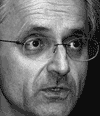kalevala by:
Karin Kaminker
ROCK HERO
Briefly in a petrol station
brown eyes capture mine in passing
brown eyes deep and deeply moving
in the doorway briefly meeting.
Sleeveless tee and tatooed biceps,
skin-tight jeans all ripped and tattered.
Shoulder-length, his hair cascading
frames a handsome face that's smiling.
Neither is he young or old, his
rockstar aura stops the time.
Passing cars make background music.
Petrol perfumes falling evening.
Drives away in a Mercedes,
heads off for a foreign land. And
I am left there still to wonder
have I seen him on a cd?
Or on one of Europe's stages?
Can it be this stranger knows that
any epic hero has his
rightful share of mystery?
comment by teacher
I was just to remind you of the task, when I detected your second contribution.
Still, here´s my comment on your first contribution:
Imagine the creation of Europe. Imagine you are the narrator relating the story of Europe´s creation.
Write 10 verses (i.e. 10 lines) following the metrical model of the Kalevala.
Now what is conspicuously absent from your contribution is the European theme.
As regards metre and rhythm, a reasonably liberal, creative and, as it were, playful approach can, and will even have to, be adopted (as opposed to a supposedly scholarly accurate one).
Here are some helpful hints:
In technical terms, the Kalevala metre is non-strophic trochaic tetrameter. A line in the metre thus consists of four trochaic feet and always equals exactly eight syllables. A line is comprised of four successive rises and falls: +-+-+-+-, where the odd-numbered syllables bear metrical stress.
The main stress in Finnish in speech is always on the first syllable of the word.
Now I am not suggesting you imitate the Finnish metre, a feat doomed to ridicule and failure, and should the effort be carried out for more than 10 lines it would be a bore,a s can be seen in Longfellows long poem ”Hiawatha”.
In my own contribution, I opted for a basic trochaic meter, with four syllbles in each verse. I was hoping to signal my awarness of the silliness of the metrical undertaking both by calling it a mock-heroic poem and, of course, by the content and by some self-reflexive lines.
What I therefore suggest is:
Reacreate in English some typcical features of the original:
- Remember its foundation in popular speech
- Play with verbs, using synonyms or near-synonyms, for stylistic effects
- What could also be imitated to great effect is the ”winnowing principle”, whereby longer words gravitate towards the end of the line.
You may particularly find helpful the strategy employed Keith Bosley, and expounded by him in his foreword to his translation of the Kalevala (Oxford Classics, 1989; 19991).
He based his translation on syllables rather than feet. He uses lines of seven syllables, ”often less, occasionally more.” He eventually arrived at ” seven, five, and nine syllables respectively” using the odd number as a formal device and letting the stresses fall where they would.
THE RULES OF THE KALEVALA METRE
Here are, first in a nutshell, then in more detail, some basic differences between German (English or German) and Finnish accent. I shoul assume that the general intro is required reading.
It is then up to you to find a way to either try to imitate the original or adopt Keith Bosley´s solution. In the first case you might have to find a way to suggest you are speaking with tongue in cheek.
The Finnish original cannot help but use alliteration, it is almost impossible to avoid. Lönnrot´s ”ordinary Karelian Finnish” has only eight vowels and twelve consonants. Enlgish alliterative verse was deemed ”uncouth” alrweady 500 years ago – and a device used ad nauseam in headlines of the British gutter press.
There is no need to employ alliterations to kalevalize your contribution, though if you, and I found it quite tempting, you might use it for humourous effects.
Unlike Germanic with its stress accent, Finnish has a tonic or pitch accent- Languages with a tonic accent tend to use it as a metrical feature: if quantity is functional, they use that. Leke ancient Greek and Latin; if it is not they count syllable, like modern Greek or the Romance languages.
The Kalevala poetry is quantitative, which makes it sound irregular to Germanic ears, and I have been told, even to most modern Finnish ears, who have been subjected to English, or, in former times, educated readers, to German poetry.
Roughly half of all known Kalevala poetry consists of ”broken lines”, i.e. lines that do not scan accentually. An example given by Finnish scholars is the beginning og the epic.
For more detailed hints at the metre see "lecture."









